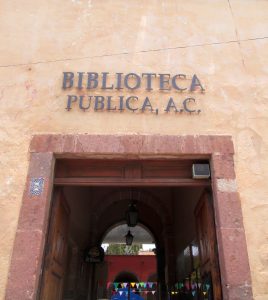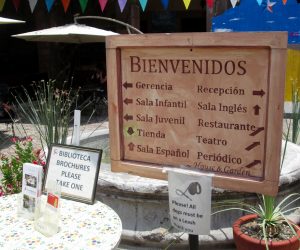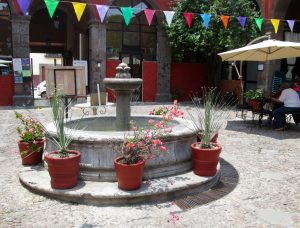Last Tuesday afternoon I joined, for the first time, a group of amateur artists who’d chosen for their weekly gathering-sketching-and-painting destination the courtyard of La Biblioteca Pública here in San Miguel de Allende.
As this group of mostly expat retirees, known as Urban Sketchers-SMA — a regional chapter of Urban Sketchers International, a network of artists around the world who draw the cities where they live and travel – fanned out around the courtyard and set to work, I focused my energies and (limited) talents on the courtyard’s central fountain. And as I did so, I couldn’t help but think: This is the hub of the hub!

San Miguel’s Biblioteca Pública (public library) is indeed the educational and cultural hub of this beautiful old colonial town. With more than 60,000 books in Spanish and English, it is the most extensive bilingual library in Mexico outside of Mexico City.
Within the Biblioteca’s large and embracing walls are offered workshops, courses, and free classes for Mexican children in computers, reading, crafts, English, math, choir, guitar, piano, science, and art. And, too, there are lectures, films, and theater for all, making it a community learning center not only for children and young adults but for the entire San Miguel community – expats and locals alike.


I learned the inspiring story of the Biblioteca’s origins from Robert de Gast’s fascinating book, The World of San Miguel de Allende: An Uncommon Guide. In 1954, Helen Wade, a Canadian expat, invited Mexican children from her neighborhood “to peruse the many magazines she had in her home.” The activity became so popular and the number of young visitors grew so large that Wade and her expat volunteers asked the state governor for a space to establish a library that would serve the entire community. In 1958 a building that had been used as the city’s slaughterhouse was leased to them.
But this building, the Biblioteca’s present home, has an even older story: In 1734 a group of priests founded a community house for poor women who were single, widowed, or abandoned by their husbands, “a sort of combination orphanage and convent,” according to de Gast, adding, “After the government expropriated church properties during the War of Reform and closed the convents, the building was left in ruins.” It became the city’s slaughterhouse in the early 20th century.
Out of these ruins (and bloody animal slaughter) the Biblioteca has risen triumphant. Today this nonprofit — which receives no government funding and relies entirely on donations, library membership fees and income from its social enterprises (such as the weekly bilingual newspaper, Atención, the weekly House & Garden tours, a gift shop, and a charming café) – is run by a paid staff of about fifty people assisted by a battalion of dedicated volunteers. According to de Gast, the Biblioteca is visited by more than five hundred adults and children every day.

I am certainly one of those visitors. Every Monday afternoon I have my private Spanish lesson at the Biblioteca with my ever-patient and good-natured teacher Edith, a single mom who is putting her son through medical school.
We sit together at one of the many wrought iron tables in the courtyard, and she spurs me along. Although she is half my age, she praises me like a proud parent when I get something (occasionally) right; and when I don’t (which is more often), she just smiles reassuringly and announces, “Don’t worry! Be happy!” So delightfully Mexican.

On other days I catch a really good movie (for only 60 pesos, or about $3) in the Biblioteca’s eighty-five seat theater, or I meet a friend at the café for a lovely four-course lunch (for only 120 pesos, or about $6), or I check out a good book, like the large-print edition of Margaret Atwood’s Blind Assassin, which I recently finished. (See April 18th WOW post, “Other People, Other Places.”) When I returned the book to the shy young Mexican librarian the other day, I enthused, “Margaret Atwood es magnífico!” He gently corrected me. “Magnífica,” he said. “Ella es femenina.”
Well, as I said, San Miguel’s Biblioteca is the hub of learning. And I am still, and always will be, learning.
[For further information about the Biblioteca or to learn how you might become a supporter, go to www.bibliotecasma.com.]
